Test your architectural IQ on student-made birdhouses
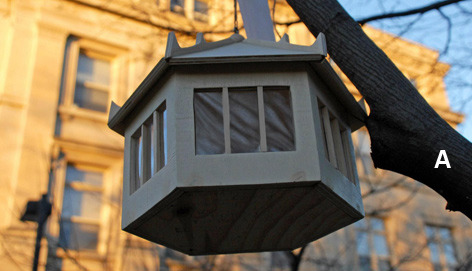
For a history of architecture class, students recently created birdhouses in the style of architects through the ages. Photos by Dan Naegele and Alison Weidemann.
Could you pick out a Frank Lloyd Wright house in a neighborhood? Do you know that Beardshear Hall was modeled after ancient Greek and Roman buildings? If you answered "yes" to either question, you might enjoy testing your architectural savvy on ... birdhouses.
The photos on this page depict just a few of the recent creations of students in professor Dan Naegele's history of architecture class. Each student's assignment was to create a birdhouse (suitable for Iowa birds and Iowa weather) in the style of 35 eras from prehistory to 1750. So it's not going to be quite as easy as finding the Frank Lloyd Wright, but you're up to the task. The houses were briefly on display earlier this week south of Beardshear.
Try matching the seven birdhouses on this page to these styles. (Two birdhouses are in the same style.) See answer key below.
- Italian Proto-Renaissance
- French Gothic
- Primitive
- Italian Renaissance
- Mughal
- Chinese Garden

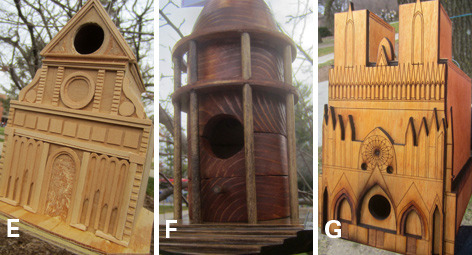
Answers:
A. Chinese Garden B. Primitive C. Mughal D. Primitive E. Italian Renaissance F. Italian Proto-Renaissance G. French Gothic
ISU physicist loans expertise to national program
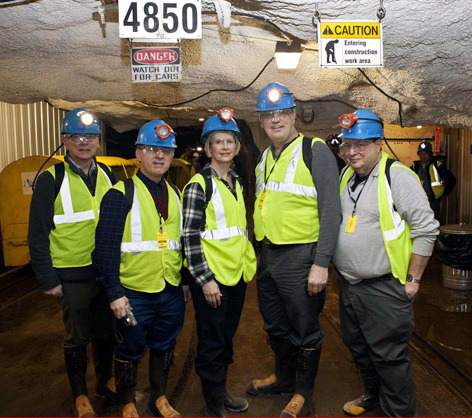
Eli Rosenberg (far right) and other physics leaders work 4,850 feet below the surface at the Homestake Mine in Lead, S.D. File photo.
Eli Rosenberg is back in his Iowa State office, papers and books spread across his desk, an inbox full of requests for assistance, stories and photos from four years of national physics work at the ready.
Rosenberg, a professor and former chair of physics and astronomy, is back on campus after four years with the High Energy Physics Program within the U.S. Department of Energy's Office of Science. He moved out of the Zaffarano Physics Addition to DOE offices in Germantown, Md., as part of a temporary assignment with the agency.
"They asked me if I was interested," said Rosenberg, a veteran of collider physics work with the BaBar Experiment at the SLAC National Accelerator Laboratory in California and the ATLAS Experiment at the Large Hadron Collider in Europe. "I could bring in outside expertise and offer advice."
Who better to prepare fact sheets and presentations for Congress than a professor with a long history of teaching physics to freshmen?
"We always have to respond to questions justifying the science," Rosenberg said. "We spend a lot of time explaining the science."
Wearing many hats, including baseball
Rosenberg helped coordinate the panels that selected the country's top early career physicists for research awards as high as $500,000 per year for five years. He worked with the QuarkNet education program. He helped manage Department of Energy research grants. (And, when he could get away, a professor famous for his physics-of-baseball lectures spent a few hours with the Nationals and the Orioles.)
But mostly, he helped manage the proposed Long Baseline Neutrino Experiment. The experiment aims to shoot a beam packed with neutrinos 800 miles from the Fermi National Accelerator Laboratory in Batavia, Ill., to the Homestake Mine in Lead, S.D. The underground beam would cut across the northern quarter of Iowa, roughly from Dubuque to Mason City to the northwest corner of the state.
If and when the experiment is turned on, Iowans are never going to notice all those neutrinos racing at nearly light speed. That's because neutrinos – even though they're among the most abundant subatomic particles in the universe – usually race through matter without leaving a trace.
The experiment would shoot the neutrinos at a massive detector that will measure how they change over time and space. The resulting data could help physicists understand why the universe is dominated by matter – even though the universe should have started with equal parts matter and antimatter.
Piecing a project together
As originally planned, the experiment was expected to cost $1.5 billion to $2 billion. But budget cuts put the project in peril. And so researchers broke the project into phases that will be completed over several years. Phase I would have a price tag of about $800 million.
As program manager for the project, Rosenberg was part of the activity that kept the proposed experiment alive. (Mayly Sanchez, an Iowa State assistant professor of physics and astronomy with a joint appointment at the DOE's Argonne National Laboratory in Illinois, also has been involved with the long baseline experiment and other ongoing neutrino projects.)
A future in physics
Now that he's back on campus, Rosenberg is thinking about what's next in his physics career.
He could return to his previous work with particle colliders and the hunt for the Higgs boson. Or, he could continue his neutrino work of the past few years. That work has taken him to experiments in Japan, China and 4,850 feet below ground in a former South Dakota gold mine – and he's happy to share photos from all those physics adventures.
The pictures show Rosenberg really has had a front row view of the country's physics future.
ISU hopes to replace three of five coal boilers
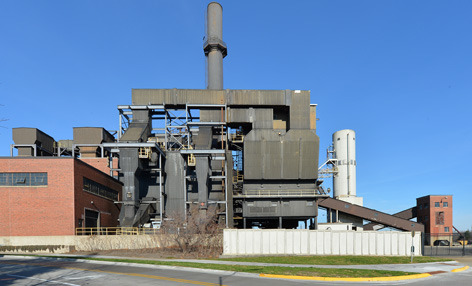
The structures and ash handling equipment to the right of the large stack will be demolished to create space on the east side of the power plant for a building that would house three natural gas-powered boilers. Photo by Bob Elbert.
If the state Board of Regents signs off on the plans next week, Iowa State will replace three of its five coal-powered boilers with natural gas boilers, effectively reducing the university's carbon footprint by 12 percent.
ISU director for utilities services Jeff Witt said the project accomplishes two objectives. It allows the university to replace boilers that are at or just beyond their expected service life (35-40 years), and it will put Iowa State in compliance with new emissions regulations proposed by the U.S. Environmental Protection Agency. (Congress has not yet approved final revisions.)
The regents meet in Ames on Dec. 5 (1 p.m., ISU Alumni Center, live audio stream available).
As proposed, the estimated $38 million project would be phased over three years in order to maintain normal operations at the power plant. The new boilers would go online in early fall 2015 and the remaining two coal-burning boilers would be retrofitted with an air pollution control system, also to comply with EPA regulations.
"The project continues ISU's commitment to improving our efficiency, lowering operating costs, reducing the university's carbon footprint and increasing clean energy to the Ames community critical to further economic development," said senior vice president for business and finance Warren Madden.
The natural gas boilers will connect to existing steam, water and electrical systems in the power plant and be used to produce steam (heat), electricity and chilled water (cooling) for the campus.
Minimal impact on campus rates
The project will be funded by utility revenue bonds, which are repaid through campus utility rates. Similar bonds sold in 1986 to pay for two coal boilers are about to be retired, so the net impact on utility rates for campus users will be minimal, Witt said.
The combination of coal- and natural gas-powered boilers will give the university flexibility to respond to market fluctuations in the future, he noted. Under normal campus energy demands, Iowa State operates three boilers. When the weather is extremely cold or when the university is producing all of its own electricity (rather than purchasing some), four boilers are in use.
While natural gas burns cleaner, its price is less stable than coal. New drilling techniques make it easier to access vast underground supplies of natural gas, which helps to bring down the price.
"We will look at pricing, and decide what to use on a monthly basis," Witt said. "We don't foresee a change from running three boilers most of the time, but it would be rare to go with no coal boilers."
Shrinking coal pile
So Iowa State's coal piles aren't going away, but the one east of Haber Road will be noticeably smaller. Witt estimates that coal use, currently about 135,000 tons per year, will drop by more than a third – or 48,000 tons annually. Fewer coal-fired boilers also will reduce the amount of ash byproduct the university has to dispose of by about 4,000 tons annually. And many power plant air emissions – sulfur dioxide, nitrogen oxide, mercury, carbon dioxide, for example -- will be dramatically clipped.
Phased construction
If the project receives board approval, two coal boilers that will be retired would be converted to natural gas temporarily next spring. The coal and ash handling equipment and structures on the east side of the power plant for those boilers would be demolished by the end of 2013 and construction of a building to house the three new boilers would begin in the spring of 2014.
Digital repository offers a campus portal to global publishing
In April, the University Library rolled out a new digital repository. The online resource offers Iowa State faculty, students and staff an open-access portal to publish and find research, scholarship and more -- all at no cost to users.
As part of the worldwide Digital Commons network of online repositories, ISU's participation gives formerly unpublished work unlimited exposure. This includes scholarly works such as theses, reports, presentations and conference papers.
"The purpose is to promote and increase the visibility and availability of the scholarly and creative output of the university," said David Gregory, associate library dean for research and access administration.
Global access
Gregory said repository material is optimized for Google and other search engines, adding the work of ISU faculty, staff and students to the list of results for online queries. The repository also has its own search function.
"We're aware most people are finding their way through Google," Gregory said. "We've seen hits from more than 150 countries. Some of the material is becoming very visible."
Gregory said other institutions have seen past research get "new life" when added to a repository. That includes work done by retired faculty that may be available online for the first time.
"That is one of the benefits of a repository," Gregory said. "Now some of the material that predates electronic publication is getting its first life online and the likelihood of people finding it is much greater."
Building a bank of information
Digital repository coordinator Harrison Inefuku has populated the site with more than 4,000 documents since April. He worked with subject librarians to help identify material for the pilot period, and word about the repository is spreading.
Inefuku said ISU's repository items have been downloaded more than 175,000 times, with as many as 2,000 downloads daily. Topics on the current list of top downloads range from Polish complicity during the Holocaust, to cost-effective hydrogen sulfide removal technology.
More than just white papers
Research and scholarship aren't the only items that can be uploaded. The repository also includes back issues of course catalogs and the Iowa State Daily; administrative documents, such as strategic plans and annual reports; and even a pair of patents from the ISU Research Foundation collection.
The digital repository isn't just for the written word, either. Inefuku said multimedia creative works can be uploaded to the repository. Audio, video and image files can be added -- including downloadable files or embedded streaming video.
What's ahead
Gregory said they've just begun to scratch the surface of what can be done with the digital repository software. For instance, it can help create and publish journals while managing the peer review process. Conferences can be planned, conducted and later published -- all within the digital repository.
"We're working our way up to that," Inefuku said. "The repository comes with a powerful publishing tool, so if they want to start new journals, that's a possibility."
Meanwhile, as the project expands, Inefuku said they plan to respond to requests as users learn more about the repository.
"It really depends on what the faculty and staff at Iowa State need," Inefuku said.
ISU Foundation names new president
Roger Neuhaus has been named president of the Iowa State University Foundation. Neuhaus currently is senior vice president for development and university campaigns at the University of Arizona Foundation, Tucson.
“I am humbled by the confidence placed in me by the ISU Foundation board of directors and President Leath,” Neuhaus said. “The opportunity to assume leadership of a very reputable and well managed organization like the ISU Foundation is not common in the world of fundraising. I will do so with integrity and great care, placing the interests of our donors and all whom we serve at the center of our core daily activities.”
The foundation’s board of directors approved Neuhaus’ appointment.
“Roger encompasses all of the skills we were seeking. We are very pleased to welcome Roger and his family back to Iowa,” said Marla Franklin, ISU Foundation board chair. “I’d like to extend my appreciation to those who served on the search committee for identifying two very strong final candidates.”
At the University of Arizona Foundation, Neuhaus is the senior executive with responsibility for all major gift fundraising as well as capital campaign planning, management and execution. In his four years at Arizona, the UA Foundation reported private gifts in excess of $600 million, including a record year of $181 million last year.
Prior to joining the University of Arizona Foundation, Neuhaus served in fundraising positions at Verde Valley Medical Center, northern Arizona; The Finley Hospital and Loras College, both in Dubuque, Iowa; and Southern Illinois University, Carbondale, where he also served as assistant director of the alumni association for six years.
“Roger’s many years of fundraising experience will make him a valuable asset to the ISU Foundation,” president Steven Leath said. “I look forward to working with him and the rest of the foundation staff as they continue to support Iowa State’s priorities.”
Labh Hira, who served as dean of the College of Business for more than 10 years, has been leading the ISU Foundation in the interim while the search was conducted. “We are so grateful for all that Labh has done for Iowa State University,” Leath said. “We are indebted to Labh, both for his outstanding work and service to the university as a faculty member and dean of the college of business, but also for the past several months as the interim president of the foundation.”
Neuhaus will begin work at the ISU Foundation on Jan. 23. He will spend the next few weeks focusing on the transition from his responsibilities in Arizona, and looks forward to meeting people and acclimating to Ames once he arrives in Iowa. Neuhaus and his wife Theresa are both Dubuque, Iowa, natives.
Recycle phonebooks, mixed paper Dec. 19-21
Iowa State's annual phonebook recycling effort will be combined with the second mixed paper recycling of 2012. Campus services teams will collect both Dec. 19-21 at buildings that submit an online request by 5 p.m. Wednesday, Dec. 12.
What's included
In addition to phonebooks, examples of eligible paper include journals, magazines, catalogs, junk mail pieces, paperback books and colored paper.
What's not included
This collection is not for white paper or newsprint (for which the university has ongoing recycling programs). Other items that are not part of this collection include:
- Hardbound textbooks
- Plastic binders or ring binders that contain eligible paper (remove paper from binders)
- Confidential materials, also for which the university has an ongoing program
Request required for pickup
"The biggest change this fall is that there isn't a preset building list and we won't automatically appear at your building to make a collection," said ISU recycling coordinator Sue Mallas. "Employees will need to send in a request; preferably they'll coordinate with others in their building and submit a single request per building."
Paper and phonebooks should be gathered in cardboard boxes – to a size and weight one person could lift – and stacked at building loading areas late in the day on Dec. 18. Questions about the collection may be directed to Mallas, 4-0692.
Phonebooks and mixed paper will be transported to International Paper in Des Moines for recycling.
Since June 2010, ISU's recycling committee has organized regular mixed paper collections for recycling. The most recent one, in June, netted 10.5 tons of mixed paper.
Lost and Found: How it works here
When it comes to reuniting lost items with their owners, Iowa Staters are a helpful lot. They'll pluck a mitten off a sidewalk and hang it on a tree. They'll post a found laptop on the lost and found site. They'll even find a way to hand-deliver a wallet holding several hundred dollars to a young man in Singapore.
Norm Hill, director of central stores, says Iowa State faculty and staff play a key role in getting belongings back to their owners. Hill, who oversees long-term storage of found items on campus, offers these guidelines.
First stop: Nearby department
Generally, the first stop for a found object is the nearest building in the vicinity. Most departments or units should keep lost objects for 10 days, then send them to central stores, 195 General Services Building. When forwarding items to central stores, include the name of the forwarding unit, where the item was found and, if known, when. Officials in high-volume areas such as Hilton Coliseum, Stephens Auditorium, Fisher Theater, Scheman Building, Alumni Center, residence halls, and recreation services, may choose to retain lost articles for longer periods.
Securing valuables
Hold valuable items, such as rings, watches, wallets and electronic devices, in a secure place. If you're uncomfortable holding an item, you may forego the 10-day wait and send it to central stores immediately.
Sample entry
Found: Gray watch
Gray watch found near Communications Building Nov. 29. Stop by 2040 Communications to identify and claim.
Using the lost and found website
Like individuals, departments can use the lost and found website to seek owners of lost property. You'll need an ISU Net-ID to post a "found" note on the website. It's wise to provide a general description, then require the claimant to further identify the object.
If campus visitors contact you for help in finding an item, it's OK to post a "lost" item on the website on their behalf.
Unclaimed property
Most items forwarded to central stores will be held for at least 90 days. Valuables will be held for 12 months. After the holding period, most unclaimed property will be sold at an ISU surplus public sale. The exceptions are unclaimed cell phones, flash drives and other portable electronic storage devices. These items, which are likely to contain individuals' personal information, are dismantled and recycled through an approved recycler. Abandoned bicycles are held by ISU police for 90 days, then sent to ISU surplus for sale.
Busy lost and found centers
Among the busiest lost and found areas on campus are:
-
Hilton Coliseum, guest service desk near lower west entrance
Items lost during athletics events at Hilton Coliseum or Jack Trice Stadium are turned in to the guest services office (enter on Hilton's west side, under the pedestrian walkway). Most lost items are maintained at the office for about six months and then turned over to central stores. Valuables, such as keys, phones, glasses, wallets, IDs and jewelry, are kept longer. Contact: ereardon@iastate.edu, 515-294-7319. -
Scheman Building, first floor lobby
The desk on the second level of Scheman is the lost-and-found area for:- The Scheman Building
- Fisher Theater
- Stephens Auditorium (During a Stephens event only, lost and found items may be reported, turned in or claimed at the guest services desk on Stephens' main floor)
- Non-athletics events at Hilton, such as all-state music activities
-
Hotel Memorial Union, front desk
Items turned into this lost-and-found center are kept about a month before they are moved on to central stores. But hotel staff manage to reunite about 40 percent of lost items with their owners in that first month. Cell phones are an oft-lost item, and a call to "mom" usually does the trick. Contact: 6-6848 or drop by the hotel desk. -
Beyer Hall, Lied Center, State Gym
Lost items are kept in the designated area for each building for two weeks. After that, items of value, such as IDs, credit cards and jewelry, are sent to central stores. Other items are discarded. -
Residence halls
Lost items are sent to the hall desks and recorded. All unclaimed items at the end of the year are sent to central stores.
Going the distance
Every department and employee on campus is part of the university lost-and-found system. See how it works.
Thousands of problem-solving Odyssey of the Mind youngsters had long left campus in the spring of 2009 when a groundskeeper spotted a small, black wallet while mowing grass near the Scheman Building. Inside the wallet was several hundred dollars and the name of a young competitor from Singapore.
The wallet was turned over to central stores officials, who tracked down the young man's school and, eventually, his parents. Then ISU administrators went to work, looking for any Singapore visitors on campus who were returning home soon. They located a scholar from a Singapore university, who subsequently carried the small wallet 9,000 miles and personally delivered it to a grateful family.
Don't be late for this very important date
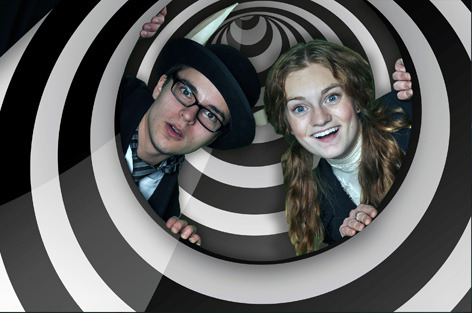
Senior Kathleen Hoil (Alice) and junior Brent LeBlanc (The White Rabbit) will perform in ISU Theatre's "Alice in Wonderland" beginning Nov. 30 at Fisher Theater. Photo illustration by Mary Bendgen and Nancy Thompson.
Just in time for the holidays, ISU Theatre presents an adaptation of Alice in Wonderland by music and theater lecturer Matt Foss. The show opens Nov. 30 for a two-weekend run at Fisher Theater.
Foss' adaptation is based on Lewis Carroll's novel Through the Looking Glass, but with a few twists. Alice's journey begins when she falls into a city trash bin (a modern version of the traditional rabbit hole) and finds herself in Wonderland. Familiar characters, such as the White Rabbit, Cheshire Cat, Mad Hatter and Queen of Hearts, transform the trash into a magical world. Foss also added puppets to the cast along with original music and lyrics.
"The play will delight all ages," Foss said. "Our aim is for it to be engaging and enjoyable for children and adults alike, where the story is accessible to all ages, with wit and sincerity that works for the adult sensibility as well."
Performances are Nov. 30, Dec. 1, 7 and 8 at 7:30 p.m.; Dec. 2 at 1 p.m.; and Dec. 9 at 2 p.m. Tickets, $16 ($8 for students), are available at the Iowa State Center ticket office or through Ticketmaster.
